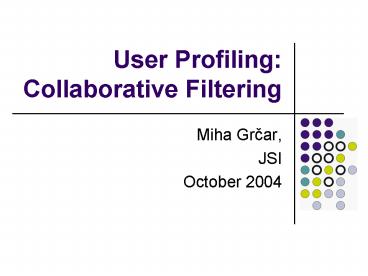User Profiling: Collaborative Filtering - PowerPoint PPT Presentation
1 / 12
Title:
User Profiling: Collaborative Filtering
Description:
... U VT, ui,k = P(ui | zk), k,k = P(zk), vj,k = P(ij | zk) M = U VT M' = U 'VT ... representing items the user already rated; the user's rating = given class label ... – PowerPoint PPT presentation
Number of Views:65
Avg rating:3.0/5.0
Title: User Profiling: Collaborative Filtering
1
User Profiling Collaborative Filtering
- Miha Grcar,
- JSI
- October 2004
2
User Profiling
- User profiling constructing a model of a user
- Goal without any effort from the user
- The profile is machine readable
- The profile reflects the users interests
- Two profiles can be compared to determine the
degree of similarity in interests of two users - Long-term, short-term interests
3
Collaborative Filtering
- Goal recommend items of interest to the active
user / try to predict the users rating of an
item - Idea consult other users (explore their
profiles) - A simple example we want to predict how much we
will like the movie Beautiful Mind - Naïve approach look at its average rating at
IMDb.com (already a collaborative approach) - Better approach ask a friend who is considered
to have a similar taste (true collaborative
filtering)
4
The k Nearest Neighbors Approach
- Define the similarity measure in order to be able
to compare two user profiles - To the active user, find k most similar users
that have rated the item in question - Predict the users rating of the item by
calculating the weighted1 average of the ratings
given to the item by other users - ????
- 1Weights are usually the similarity values.
- 2 fundamental problems
- Sparsity of the data
- Scalability problem
5
Similarity Measures
- Cosine similarity
- Used in information retrieval
- Pearson correlation coefficient
- Used in statistics to evaluate the degree of
linear relationship between two variables
6
Weights
- Weight is proportional to similarity value
- Confidence in computed weights
- many overlapping values?? high
- few overlapping values?? low
- Weights amplification reward weights closer to 1
and punish those closer to 0 - Inverse user frequency universally liked items
are less relevant for predictions - (log n / nj)
7
The Sparsity Problem
- Many missing values in feature vectors
- Solving the sparsity problem
- Default rating
- Using content
- Dimensionality reduction techniques also
counter the scalability issue! - Simple approaches
- Remove users with low support
- Random sampling
- More advanced
- Latent Semantic Analysis (LSA)
- Probabilistic LSA (pLSA)
8
Latent Semantic Analysis (LSA)
- On the basis of Singular Value Decomposition
(SVD) - M U?VT ? M U?VT
- M the user-item matrix
- ? the diagonal matrix of the singular values of
M - U, V two unitary matrices
9
Probabilistic Latent Semantic Analysis (pLSA)
- On the basis of LSA (SVD)
- Observation pair (u, i)
- P(u, i) P(z)P(u z)P(i z) z latent
variable - P(u, i) ? P(i u)
- Incorporating a rating value
- P(u, i, r) ? P(i, r u)
- Relation to LSA (SVD)
- M U?VT, ui,k P(ui zk),??k,k P(zk), vj,k
P(ij zk) - M U?VT ? M U?VT
10
CF as a Classification Task
- Classes different rating scores
- For each user we train a separate classifier
- Train set feature vectors representing items the
user already rated the users rating given
class label - Test set feature vectors representing items the
user did not rate yet classification
prediction of the users rating of the item - A problem with the sparsity of the data
- Possible solution representing one user with
many instances
11
Item-based CF
- First compute item-to-item similarities
- To predict user us rating of item i, compute a
weighted average of k most similar items to item
i that u already rated - User-user similarity measures can be applied to
compute item-item similarities
12
- Thank you.






























